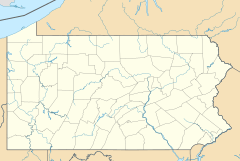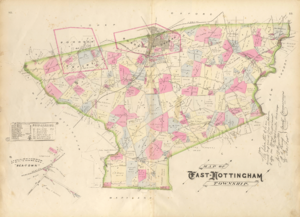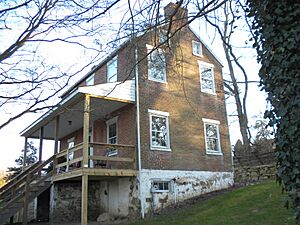Hopewell, Chester County, Pennsylvania facts for kids
Quick facts for kids
Hopewell, Pennsylvania
|
|
|---|---|
|
Unincorporated community & Former Borough
|
|
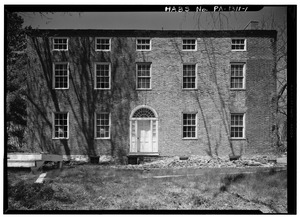
The Second Hopewell Academy
|
|
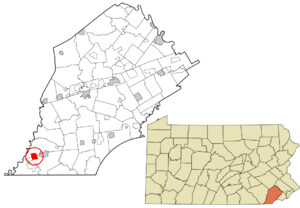
Approximate location in Chester County and the U.S. state of Pennsylvania
|
|
| Country | United States |
| State | Pennsylvania |
| County | Chester |
| Townships | East Nottingham & Lower Oxford |
| Incorporated as Borough | 2 May 1853 |
| Unincorporated | 1914 |
| Elevation | 344 ft (105 m) |
| Demonym(s) | Hopewellian |
| Time zone | UTC-5 (Eastern (EST)) |
| • Summer (DST) | UTC-4 (EDT) |
| GNIS feature ID | 1203835 |
Hopewell is a small community in Chester County, Pennsylvania, United States. It used to be an independent town, known as a borough. Today, it is an unincorporated community, meaning it is part of larger townships rather than having its own local government.
Hopewell became a borough on May 2, 1853. However, its population decreased in the late 1800s. Because of this, it was reabsorbed into East Nottingham and Lower Oxford townships in 1914. Hopewell is located about 344 feet (105 meters) above sea level. It is also home to the Hopewell Historic District, which helps preserve its past.
Contents
The Story of Hopewell
Early Beginnings
Hopewell's history began with the Dickey family. They arrived in East Nottingham Township from Northern Ireland in the 1730s. Samuel Dickey, Sr., bought land and built an estate called “Palmyra.” His son, Samuel Dickey, Jr., took over the estate and added a carpenter shop and a brick oven.
Samuel Dickey, Jr., had four sons. Two of them, Samuel III and David, inherited parts of Palmyra. Samuel III built a small cotton mill in 1809. By 1812, he had another cotton mill on Tweed Creek, where Hopewell would later grow. David also built mills for making flour and wood products nearby. The brothers then combined their businesses to form the Hopewell Cotton Works. Around 1816, their brother Ebenezer joined them, and they became known as S. E. & D. Dickey.
Growing into a Borough
The Hopewell Cotton Works first made cotton yarn. Later, it produced many different types of fabric. The mill needed skilled workers, which brought more people to the area. As the business grew, the Dickey brothers built homes for their workers to rent. Hopewell also got a general store. The town's public school opened in 1826, and the Hopewell Post Office opened in the general store in 1830.
After David and Ebenezer passed away in 1831, Samuel III took full control of the Hopewell Works. In 1834, a private school called Hopewell Academy opened. When Samuel Dickey III died in 1835, his sons Samuel J., Ebenezer J., and David J. took over the family businesses. They were known as S. J. Dickey and Brothers. At this time, Hopewell Works included two cotton mills, a sawmill, a gristmill, the general store, and other shops.
The new generation of Dickeys also became successful farmers. Ebenezer J. even invented a seed drill and a "butter worker." In 1841, a former teacher named Jesse C. Dickey opened a new Hopewell Academy. This school taught many subjects, like math, Latin, and chemistry. It offered an education similar to two years of college.
Hopewell continued to grow. In 1848, residents asked the county government to change the border of Lower Oxford Township. They wanted all of Hopewell to be in one area. When this failed, they asked for Hopewell to become a borough. This request was approved. On May 2, 1853, Hopewell became its own borough, taking land from Lower Oxford and East Nottingham Townships.
Challenges and Changes
By 1860, the Hopewell Mill was very successful. However, this year also marked the start of Hopewell's decline. Around this time, the Philadelphia and Baltimore Central Railroad was built. It went through Oxford instead of Hopewell. Oxford's population grew rapidly, while Hopewell's began to shrink. Many people moved to Oxford for better opportunities.
The second Hopewell Academy closed in 1861. The start of the Civil War also hurt the borough. S. J. Dickey and Brothers faced problems due to cotton shortages and poor management. Their businesses were sold off in 1862. Even though some parts of the works reopened, farming became the main way people made a living in Hopewell.
There was a brief hope for recovery in the late 1860s and early 1870s. The Hopewell Cotton Works briefly improved around 1869. Hopewell finally got a railroad connection in 1872 with the Peach Bottom Railway. In 1875, the Hopewell Lyceum, a social club, was founded. But these efforts could not stop the town's overall decline.
By 1870, most of the Dickey family had left Hopewell, many moving to Oxford. The Chester County Milk Company closed by 1879, and the grist mill burned down. People in Hopewell started to feel more connected to Oxford and Nottingham than to Hopewell itself. By 1897, many of the town's eligible voters held positions in the local government. Even women held some offices, which was very unusual for the time. Hopewell had become a very small community.
Becoming Part of Townships Again
Some Hopewell residents, led by Elwood Webster, wanted to end the borough's special status in the mid-1890s. They were unhappy with high taxes and poor road conditions. The salaries for borough officers and the cost of yearly elections were also expensive. Others, led by Squire Thompson Hudson, wanted to keep the borough. The first attempt to dissolve the borough failed.
A second attempt began in 1913, led by Burgess David F. Cope. To move forward, two-thirds of the taxable residents had to agree. The necessary signatures were collected. After Cope's death in 1913, W. D. Harra continued the effort. He presented the request to the county court in West Chester on August 25, 1913. Despite Thompson Hudson's arguments, the court approved the dissolution on December 23. Squire Thompson Hudson appealed the decision until August 1914, but it was unsuccessful.
The Borough of Hopewell was officially dissolved in early 1914. Its land was returned to East Nottingham and Lower Oxford Townships. In 1991, the Hopewell Historic District was created. This district helps protect the remaining historic buildings of the former borough.
Hopewell Today
Many of the old buildings in Hopewell, like the Academy and the Post Office, are now part of the Hopewell Historic District. Today, Hopewell is home to Hanover Farms, Hopewell UMC, and Boy Scouts of America Troop 8.


